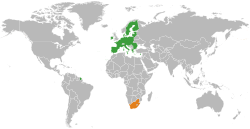 | |
European Union |
South Africa |
|---|---|
The European Union (EU) has strong cultural and historical links to South Africa (particularly through immigration from the Netherlands, Ireland, Germany, France, and Greece) and the EU is South Africa's biggest investor.
Comparison table
| Population | 447,706,209 | 58,775,022 |
| Area | 4,475,757 km2 (1,728,099 sq mi) | 1,221,037 km2 (471,445 sq mi) |
| Population Density | 117.2/km2 (303.5/sq mi) | 42.4/km2 (109.8/sq mi) |
| Capital | Brussels | Pretoria |
| Government | Supranational and intergovernmental union | Unitary dominant-party parliamentary constitutional republic |
| Current leader | Council President Charles Michel Commission President Ursula von der Leyen |
President Cyril Ramaphosa Deputy President David Mabuza |
| Official Languages | 24 official languages, of which 3 considered "procedural" (English, French and German) | 11 official languages, English, Afrikaans, Sepedi, Sesotho, Setswana, siSwati, Tshivenda, Xitsonga, isiNdebele, isiXhosa, isiZulu |
| Main Religions |
|
|
| Ethnic Groups | Germans (ca. 80 million), French (ca. 67 million), Italians (ca. 60 million), Spanish (ca. 47 million), Poles (ca. 46 million), Romanians (ca. 16 million), Dutch (ca. 13 million), Greeks (ca. 11 million), Portuguese (ca. 11 million), |
80.7% Black African, 8.8% Coloured, 7.9% White, 2.6% Asian |
| GDP (nominal) | $16.477 trillion, $31,801 per capita | $369.854 billion, $6,193 per capita |
Agreements
Since the end of South Africa's apartheid, EU South African relations have flourished and they began a "Strategic Partnership" in 2007. In 1999 the two sides signed a Trade, Development and Cooperation Agreement (TDCA) which entered into force in 2004, with some provisions being applied from 2000. The TDCA covered a wide range of issues from political cooperation, development and the establishment of a free trade area (FTA). The liberalisation schedules were completed by 2012. Since the signing of the Agreement, trade in goods between the two partners has increased by more than 120%, and foreign direct investment has grown five-fold.
Trade
South Africa is the EU's largest trading partner in Southern Africa and has a FTA with the EU. South Africa's main exports to the EU are fuels and mining products (27%), machinery and transport equipment (18%) and other semi-manufactured goods (16%). However they are growing and becoming more diverse. European exports to South Africa are primarily machinery & transport equipment (50%), chemicals (15%) and other semi-machinery (10%).
| EU – South Africa trade in 2013 | ||||
|---|---|---|---|---|
| Direction of trade | Goods | Services | Investment stocks | |
| EU to South Africa | €24.5 billion | €7.2 billion | €41.8 billion | |
| South Africa to EU | €15.6 billion | €4.5 billion | €7.7 billion | |
South Africa's foreign relations with EU member states
See also
- Foreign relations of the European Union
- Foreign relations of South Africa
- African, Caribbean and Pacific Group of States
- General Representation of the Government of Flanders in Pretoria
References
- ^ South Africa, European External Action Service
- "European Commission - PRESS RELEASES - Press release - Frequently asked questions on languages in Europe". europa.eu. Retrieved 2017-06-24.
- "DISCRIMINATION IN THE EU IN 2015", Special Eurobarometer, 437, European Union: European Commission, 2015, retrieved 15 October 2017 – via GESIS
- ^ Bilateral relations South Africa, European Commission
External links
- EU delegation to South Africa
- South Africa - European Commission Aid and Development
- Outlook on Europe: South Africa’s Relations with the European Union Since the End of Apartheid
| |||||||||||||||
| |||||||||||||||
| |||||||||||||||